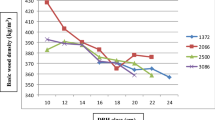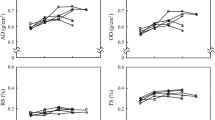Summary
Several factors which may affect the shrinkage of wood had been studied using loblolly pine (Pinus taeda L.). It was observed that volumetric, tangential and radial shrinkages decreased as the height increased. Longitudinal shrinkage increased with height. Only tangential shrinkage was significantly affected by the distance from the pith factor. All shrinkages were found to vary significantly according to cardinal directions. For the trees studied, lower volumetric, tangential and radial shrinkages were observed for specimens from the south side of the pith. Longitudinal shrinkage was noticeably higher in this direction.
Although shrinkage of wood for any given specific gravity was found to vary somewhat with trees, it was, in general, significantly affected by specific gravity. Volumetric, tangential and radial shrinkages increased with increasing specific gravity. The opposite was true for longitudinal shrinkage. According to regression equations derived from this study, tangential, radial and longitudinal shrinkage values were not zero but 2.79–3.45, and 0.526 percent, respectively, at zero specific gravity. Above 0.72 specific gravity, radial shrinkage of the species studied was found to be greater than tangential shrinkage.
The effect of growth rate (number of rings per inch) on shrinkage was found to be insignificant.
Zusammenfassung
Verschiedene, die Schwindung beeinflussende Faktoren wurden an Holz von Loblolly pine (Pinus taeda L.) untersucht. Es wurde festgestellt, daß die Volumenschwindung, die tangentiale und die radiale Schwindung mit zunehmender Höhenlage der Proben im Stamm abnahmen, während die Längsschwindung größer wurde. Nur die tangentiale Schwindung wurde deutlich vom Abstand der Probe von der Markröhre beeinflußt. Es zeigte sich ferner, daß alle Schwindungswerte in Abhängigkeit von den Himmelsrichtungen beträchtlich schwankten. Bei den untersuchten Bäumen waren die Volumenschwindung, die tangentiale und die radiale Schwindung von Probestücken aus dem nach Süden liegenden Stammteil geringer, wogegen die Längsschwindung in dieser Richtung merklich größer war.
Trotz gewisser Schwankungen von Stamm zu Stamm erwies sich die Schwindung deutlich von der Dichte abhängig. Die Volumenschwindung, die tangentiale und radiale Schwindung nahmen mit zunehmender Dichte ebenfalls zu, wohingegen die Längsschwindung abnahm. Die mit den erhaltenen Werten aufgestellten Regressionsgleichungen ergaben für die Tangential-, Radial- und Längsschwindung bei einer Dichte von 0 nicht ebenfalls 0, sondern 2,79%,-3,45% und 0,527%. Für Dichten über 0,72% wurde die radiale Schwindung der untersuchten Proben größer als die tangentiale.
Die Wachstumsgeschwindigkeit (Anzahl der Jahrringe pro cm) hatte keinen signifikanten Einfluß auf die Schwindung.
Similar content being viewed by others
References
American Society of Testing Materials: D 143–52. Standard Methods of Testing Small Clear Specimens of Timber (1952).
Barber, N. F., and B. A. Meylan: The Anisotropic Shrinkage of Wood. Holzforschung Vol. 18 (1964) No. 5, p. 146/156
Bisset, I. J. W.: Some New Aspects of the Growth, Structure and Physical Properties of Wood. M. Sc. Thesis, Univ. of Melbourne (1951).
Goggans, J. F.: The Correlation, Variation, and Inheritance of Wood Properties in Loblolly Pine. North Carolina State College, School of Forestry Tech. Rept. 11 (1962).
Greenhill, W. L.: The Shrinkage of Australian Timbers, Pt. 1. Coun. Sci. Ind. Res., Aust., Pamphlet No. 67 (1936).
Greenhill, W. L.: The Shrinkage of Australian Timbers, Pt. 11. Coun. Sci. Ind. Res., Aust., Pamphlet No. 97 (1940).
Harris, J. M., and B. A. Meylan: The Influence of Microfibril Angle on Longitudinal and Tangential Shrinkage in Pinus radiata. Holzerforschung Vol. 19 (1965) No. 5, p. 144/153.
Hiller, C. H.: Variations in Fibril Angles in Slash Pine. FPL, FS, USDA, Rept. No. 2003 (1954).
Kelsey, K. E.: The Shrinkage Intersection Point its Significance and The Method of its Determination. For. Prod. J. Vol. IV (1956) No. 10, p. 411/417.
Kelsey, and R. S. T. Kingston: An Investigation of Standard Methods for Determining the Shrinkage of Wood. For. Prod. J. Vol. III (1953) No. 4, p. 49/53.
Koehler, A.: Rapid Growth Hazards Usefulness of Southern Pine. J. For. Vol. 36 (1938) No. 2, p. 153–159.
Liese, W., and H. E. Dadswell: On the Influence of Cardinal Points on the Lengths of Wood Fibers and Tracheids. Holz als Roh- u. Werkstoff Bd. 17 (1959) p. 421/427.
Nakato, K.: On the Cause of Anisotropic Shrinkage and Swelling of Wood. Jap. Wood Res. Soc. Vol. 4 (1958) No. 3, p. 94/105.
Paul, B. H.: Variation in the Specific Gravity of the Springwood and Summerwood of Four Species of Southern Pines. J. For. Vol. 37 (1939) No. 1, p. 478/482.
—: Reducing Bowing and Crooking of Lumber Cut from Second-Growth Southern Yellow Pine. South. Lumberman. Vol. 156 (1962), p. 48/50.
Paul, B. H., and C. H. Hiller: Patterns of Variation in Fibril Angles in Loblolly Pine. FPL, FS, USDA, Rept. No. 1935 (1959).
Paul, B. H., and D. M. Smith: Summary on Growth in Relation to Quality of Southern Yellow Pine. FPL, FS, USDA, Rept. No. 1751 (1956).
Pentoney, R. E.: Mechanisms Affecting Tangential vs. Radial Shrinkage. J. For. Prod. Res. Soc. Vol. III (1953) No. 2, p. 27/32.
Pillow, M. Y.: Specific Gravity Relative to Characteristics of Annual Rings in Loblolly Pine, FPL, FS, USDA, Rept. No. 1989 (1954).
Pillow, M. Y., and C. V. Sweet: Quality Control in Manufacture of Lumber from Second-Growth. FPL, FS, USDA, Rept. No. R 1781 (1949).
Preston, R. D.: Anisotropic Contraction of Wood and of its Constituent Cells. Forestry Vol. 16 (1942) No. 32.
—: The fine Structure of The Walls of the Conifer Tracheid. 11. Optical Properties of Dissected Cells in Pinus insignis. Proc. Roy. Soc. London, Serv. B 134 (1947), p. 202/218.
—: The Molecular Architecture of Plant Cell Walls, London 1952: Chapman & Hall, Ltd.
Stamm, A. J.: Shrinkage and Swelling of Wood. Ind. Eng. Chem. Vol. 27 (1935), p. 401/406.
—: Specific Volume of Native Cellulose. Textile Res. J. Vol. 20 (1950), p. 631/636.
—: Wood and Cellulose Science, Ch. 13, p. 227. New York 1964: Ronald Press.
—: Variation in Shrinking and Swelling of Wood. Trans. Amer. Soc. Mech. Eng. Vol. 63 (1942), p. 379/386.
U.S. Dept. of Agr.: Longitudinal Shrinkage of Wood. For. Prod. Lab. Rept. No. 1093 (1960).
Yandle, D. O.: Statistical Evaluation of the Effect of Age on Specific Gravity in Loblolly Pine. FPL, FS, USDA, Rept. No. 2049 (1956).
Yao, J.: Modified Mercury Immersion Method in Determining Specific Gravity of Small, Irregular Wood Specimens. For. Prod. J. Vol. 18 (1968) No. 2, p. 56/69.
Author information
Authors and Affiliations
Rights and permissions
About this article
Cite this article
Yao, J. Shrinkage properties of second-growth southern yellow pine. Wood Science and Technology 3, 25–39 (1969). https://doi.org/10.1007/BF00349982
Received:
Issue Date:
DOI: https://doi.org/10.1007/BF00349982




